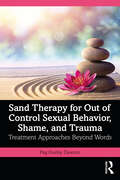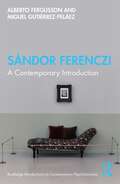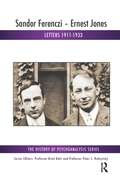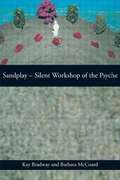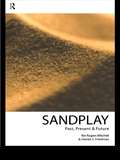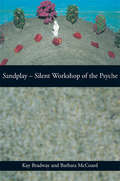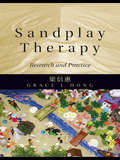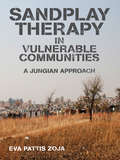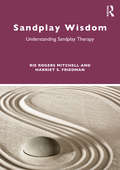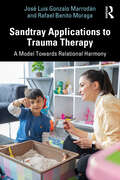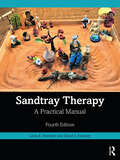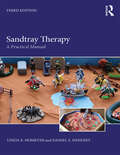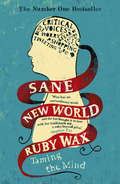- Table View
- List View
Sand Therapy for Out of Control Sexual Behavior, Shame, and Trauma: Treatment Approaches Beyond Words
by Peg Hurley DawsonThis book is designed to educate sex therapists and mental health professionals on the power of using sand when treating sexual issues, providing guidance in accessing their clients’ unconscious to seek new ways of healing. Uniquely integrating sex therapy with sand therapy, Dawson describes how understanding and applying non-pathological theories and neuroscience to different modalities, such as Internal Family Systems and Polyvagal Theory, can help clients move forward from shame, sexual dysfunctions, and trauma. The book begins by introducing how therapists can use sand as a doorway into using metaphor and imagery in their practice, with information on how the nervous system keeps somatic experiences trapped in the body being explored. Written in an easy, accessible style, the book also includes handouts, belief cards, and case studies throughout to help therapists see the benefits of using sand with clients in practice. Including forewords by Dr. Lorraine Freedle and Doug Braun-Harvey, this book is geared toward mental health professionals, such as sex therapists and marriage and family therapists, who are working with individuals and couples seeking treatment from complex trauma and mental and sexual health issues. It will appeal to students as well as advanced mental health clinicians looking to expand their therapeutic tool kit.
Sándor Ferenczi: A Contemporary Introduction (Routledge Introductions to Contemporary Psychoanalysis)
by Alberto Fergusson Miguel Gutiérrez-PeláezThis book aims to present an up-to-date introduction and critical study of one of the most important psychoanalysts of all times, Sándor Ferenczi. The book presents Ferenczi as a person; his discovery of psychoanalysis and his relationship with Freud; the theoretical and clinical novelties he introduced to psychoanalysis; his deep political and social commitment, striving for the democratization of psychoanalysis; and the great relevance of his thought and perspective for the future. It also talks about his repression in the history of psychoanalysis as well as his influence in the following generations of psychoanalysts. The reader will be presented with the most relevant historical milestones and concepts, with new insights regarding some of Ferenczi’s most fundamental ideas (such as his trauma theory, his technical innovations or his developments regarding the end of analysis), as well as an informed viewpoint of his legacy, the contemporary readings of his work and the institutions and associations that continue following the path traced by l’enfant terrible of psychoanalysis. This book will be of interest both for the novel reader who has had none or scarce contact with the person and/or work of Sándor Ferenczi, as well as to the psychoanalysts, clinicians and scholars, who have a deeper contact and understanding of the work of the Hungarian analyst.
Sándor Ferenczi: A Contemporary Introduction (Routledge Introductions to Contemporary Psychoanalysis)
by Alberto Fergusson Miguel Gutiérrez-PeláezThis book aims to present an up-to-date introduction and critical study of one of the most important psychoanalysts of all times, Sándor Ferenczi. The book presents Ferenczi as a person; his discovery of psychoanalysis and his relationship with Freud; the theoretical and clinical novelties he introduced to psychoanalysis; his deep political and social commitment, striving for the democratization of psychoanalysis; and the great relevance of his thought and perspective for the future. It also talks about his repression in the history of psychoanalysis as well as his influence in the following generations of psychoanalysts. The reader will be presented with the most relevant historical milestones and concepts, with new insights regarding some of Ferenczi’s most fundamental ideas (such as his trauma theory, his technical innovations or his developments regarding the end of analysis), as well as an informed viewpoint of his legacy, the contemporary readings of his work and the institutions and associations that continue following the path traced by l’enfant terrible of psychoanalysis. This book will be of interest both for the novel reader who has had none or scarce contact with the person and/or work of Sándor Ferenczi, as well as to the psychoanalysts, clinicians and scholars, who have a deeper contact and understanding of the work of the Hungarian analyst.
Sandor Ferenczi - Ernest Jones: Letters 1911-1933 (The History of Psychoanalysis Series)
by Sandor Ferenczi Ernest JonesThe Ferenczi-Jones correspondence presented here is an important document of the early history of psychoanalysis. It spans more than two decades, and addresses many of the relevant issues of the psychoanalytic movement between 1911-1933, such as Freud's relation to Stekel, Adler and Jung; the First World Wa;, the debates of the 1920s regarding the theoretical and technical ideas of Rank and Ferenczi; problems of leadership, structure, and finding a centre for the psychoanalytical movement; as well as issues related to telepathy and lay analysis. It includes thirty-seven letters and six postcards, as well as original documents waiting to be found for eight decades; these belong to the 'private', personal history of psychoanalysis and help to decode diverse aspects of the experience preserved in these documentary memories of former generations.Perhaps the most interesting aspect of this correspondence is how it allows us to build up a far more nuanced picture of the development of an extraordinary relationship between Ferenczi and Jones. It could hardly be termed harmonious, and was not devoid of rivalry and jealousy, sometimes even of hidden passion and outright hostility. Nevertheless, friendship, sympathy, collegiality and readiness for cooperation were just as important for Ferenczi and Jones as rivalry, mistrust and suspicion. This volume celebrates the 100th anniversary of the foundation in 1913 of both the British and the Hungarian Psychoanalytical Societies.
Sandor Ferenczi - Ernest Jones: Letters 1911-1933 (The History of Psychoanalysis Series)
by Sandor Ferenczi Ernest JonesThe Ferenczi-Jones correspondence presented here is an important document of the early history of psychoanalysis. It spans more than two decades, and addresses many of the relevant issues of the psychoanalytic movement between 1911-1933, such as Freud's relation to Stekel, Adler and Jung; the First World Wa;, the debates of the 1920s regarding the theoretical and technical ideas of Rank and Ferenczi; problems of leadership, structure, and finding a centre for the psychoanalytical movement; as well as issues related to telepathy and lay analysis. It includes thirty-seven letters and six postcards, as well as original documents waiting to be found for eight decades; these belong to the 'private', personal history of psychoanalysis and help to decode diverse aspects of the experience preserved in these documentary memories of former generations.Perhaps the most interesting aspect of this correspondence is how it allows us to build up a far more nuanced picture of the development of an extraordinary relationship between Ferenczi and Jones. It could hardly be termed harmonious, and was not devoid of rivalry and jealousy, sometimes even of hidden passion and outright hostility. Nevertheless, friendship, sympathy, collegiality and readiness for cooperation were just as important for Ferenczi and Jones as rivalry, mistrust and suspicion. This volume celebrates the 100th anniversary of the foundation in 1913 of both the British and the Hungarian Psychoanalytical Societies.
Sandplay: Silent Workshop Of The Psyche (PDF)
by Kay Bradway Barbara McCoardSandplay is a growing field of interest for Jungian and other psychotherapists. Sandplay - Silent Workshop of the Psycheby Kay Bradway and Barbara McCoard, provides an introduction to sandplay as well as extensive new material for those already using this form of therapy. Based on the authors' wide-ranging clinical work, it includes: in-depth sandplay case histories material from a wide range of adults and children over 90 illustrations in black and white and colour detailed notes on interpretation of sand trays an examination of symbols and concepts used in sandplay. Clearly written and soundly based in theory, this book provides historical background for understanding sandplay as well as helpful discussion of how it works in a clinical context. Kay Bradway and Barbara McCoard bring their indispensable personal experience to the subject to stress the healing potential of sandplay. They also reflect on the nature of a therapy where the psyche works largely in silence.
Sandplay: Past, Present and Future
by Harriet S. Friedman Rie Rogers MitchellSandplay is one of the fastest growing therapies. What are its origins, who were it pioneers, and how have they influenced the current practice of sandplay? What does the future hold? Rie Rogers Mitchell and Harriet S. Friedman have written a unique book that answers all these questions and many more. They give an overview of the historical origins of sandplay, including biographical profiles of the innovators together with discussions of their seminal writings. The five main therapeutic trends are explored, and in a final chapter the future of sandplay is discussed through addressing emerging issues and concerns. A special feature is a comprehensive international bibliography as well as a listing of sandtray videotapes and audiotapes.
Sandplay: Past, Present and Future
by Harriet S. Friedman Rie Rogers MitchellSandplay is one of the fastest growing therapies. What are its origins, who were it pioneers, and how have they influenced the current practice of sandplay? What does the future hold? Rie Rogers Mitchell and Harriet S. Friedman have written a unique book that answers all these questions and many more. They give an overview of the historical origins of sandplay, including biographical profiles of the innovators together with discussions of their seminal writings. The five main therapeutic trends are explored, and in a final chapter the future of sandplay is discussed through addressing emerging issues and concerns. A special feature is a comprehensive international bibliography as well as a listing of sandtray videotapes and audiotapes.
Sandplay: Past, Present And Future (PDF)
by Rie Rogers Mitchell Harriet S. FriedmanSandplay is one of the fastest growing therapies. What are its origins, who were it pioneers, and how have they influenced the current practice of sandplay? What does the future hold? Rie Rogers Mitchell and Harriet S. Friedman have written a unique book that answers all these questions and many more. They give an overview of the historical origins of sandplay, including biographical profiles of the innovators together with discussions of their seminal writings. The five main therapeutic trends are explored, and in a final chapter the future of sandplay is discussed through addressing emerging issues and concerns. A special feature is a comprehensive international bibliography as well as a listing of sandtray videotapes and audiotapes.
Sandplay: Past, Present And Future
by Rie Rogers Mitchell Harriet S. FriedmanSandplay is one of the fastest growing therapies. What are its origins, who were it pioneers, and how have they influenced the current practice of sandplay? What does the future hold? Rie Rogers Mitchell and Harriet S. Friedman have written a unique book that answers all these questions and many more. They give an overview of the historical origins of sandplay, including biographical profiles of the innovators together with discussions of their seminal writings. The five main therapeutic trends are explored, and in a final chapter the future of sandplay is discussed through addressing emerging issues and concerns. A special feature is a comprehensive international bibliography as well as a listing of sandtray videotapes and audiotapes.
Sandplay: Silent Workshop of the Psyche
by Kay Bradway Barbara McCoardSandplay is a growing field of interest for Jungian and other psychotherapists. Sandplay - Silent Workshop of the Psyche by Kay Bradway and Barbara McCoard, provides an introduction to sandplay as well as extensive new material for those already using this form of therapy. Based on the authors' wide-ranging clinical work, it includes: in-depth sandplay case histories material from a wide range of adults and children over 90 illustrations in black and white and colour detailed notes on interpretation of sand trays an examination of symbols and concepts used in sandplay. Clearly written and soundly based in theory, this book provides historical background for understanding sandplay as well as helpful discussion of how it works in a clinical context. Kay Bradway and Barbara McCoard bring their indispensable personal experience to the subject to stress the healing potential of sandplay. They also reflect on the nature of a therapy where the psyche works largely in silence.
Sandplay: Silent Workshop of the Psyche
by Kay Bradway Barbara McCoardSandplay is a growing field of interest for Jungian and other psychotherapists. Sandplay - Silent Workshop of the Psyche by Kay Bradway and Barbara McCoard, provides an introduction to sandplay as well as extensive new material for those already using this form of therapy. Based on the authors' wide-ranging clinical work, it includes: in-depth sandplay case histories material from a wide range of adults and children over 90 illustrations in black and white and colour detailed notes on interpretation of sand trays an examination of symbols and concepts used in sandplay. Clearly written and soundly based in theory, this book provides historical background for understanding sandplay as well as helpful discussion of how it works in a clinical context. Kay Bradway and Barbara McCoard bring their indispensable personal experience to the subject to stress the healing potential of sandplay. They also reflect on the nature of a therapy where the psyche works largely in silence.
Sandplay Therapy: Research and Practice
by Grace L. HongThis book explores the essence of sandplay therapy. Drawing on Grace Hong’s extensive work in the field the book discusses this unique, creative and nonverbal approach to therapy. The book focuses on her experiences in practice, research and teaching from both the US and Taiwan.
Sandplay Therapy: Research and Practice
by Grace L. HongThis book explores the essence of sandplay therapy. Drawing on Grace Hong’s extensive work in the field the book discusses this unique, creative and nonverbal approach to therapy. The book focuses on her experiences in practice, research and teaching from both the US and Taiwan.
Sandplay Therapy in Vulnerable Communities: A Jungian Approach
by Eva Pattis ZojaSandplay Therapy in Vulnerable Communities offers a new method of therapeutic care for people in acute crisis situations such as natural disasters and war, as well as the long-term care of children and adults in areas of social adversity including slums, refugee camps and high-density urban areas. This book provides detailed case studies of work carried out in South Africa, China and Colombia and combines practical discussions of expressive sandwork projects with brief overviews of their sociohistoric background. Further topics covered include: the social aspect of psychoanalysis the importance of play pictographic writing and the psyche. Providing the reader with clear, practical instructions for carrying out their own sandwork project, this book will be essential reading not only for psychotherapists involved with sandplay therapy but also for those with an interest in cross cultural psychotherapy, as well as all professionals working with those in situations of social adversity.
Sandplay Therapy in Vulnerable Communities: A Jungian Approach
by Eva Pattis ZojaSandplay Therapy in Vulnerable Communities offers a new method of therapeutic care for people in acute crisis situations such as natural disasters and war, as well as the long-term care of children and adults in areas of social adversity including slums, refugee camps and high-density urban areas. This book provides detailed case studies of work carried out in South Africa, China and Colombia and combines practical discussions of expressive sandwork projects with brief overviews of their sociohistoric background. Further topics covered include: the social aspect of psychoanalysis the importance of play pictographic writing and the psyche. Providing the reader with clear, practical instructions for carrying out their own sandwork project, this book will be essential reading not only for psychotherapists involved with sandplay therapy but also for those with an interest in cross cultural psychotherapy, as well as all professionals working with those in situations of social adversity.
Sandplay Wisdom: Understanding Sandplay Therapy
by Rie Rogers Mitchell Harriet S. FriedmanSandplay Wisdom provides key concepts for understanding and using sandplay therapy effectively, distilling insight from more than four decades of experience. Rie Rogers Mitchell and Harriet S. Friedman provide both core principles and hard-won practical tips to deepen understanding of sandplay therapy for both experienced and novice practitioners. The principles presented provide key insight into many important therapeutic dimensions, including childhood trauma, archetypal life stages, age and gender issues, transference and countertransference, as well as sandplay with both adults and children. The book is illustrated with case material and images from real sessions throughout and provides invaluable guidance on working with clients in a vast range of contexts. This important book will be essential reading for all sandplay therapists in practice and in training. It will also be of great interest to practitioners, academics and scholars of play and arts therapies.
Sandplay Wisdom: Understanding Sandplay Therapy
by Rie Rogers Mitchell Harriet S. FriedmanSandplay Wisdom provides key concepts for understanding and using sandplay therapy effectively, distilling insight from more than four decades of experience. Rie Rogers Mitchell and Harriet S. Friedman provide both core principles and hard-won practical tips to deepen understanding of sandplay therapy for both experienced and novice practitioners. The principles presented provide key insight into many important therapeutic dimensions, including childhood trauma, archetypal life stages, age and gender issues, transference and countertransference, as well as sandplay with both adults and children. The book is illustrated with case material and images from real sessions throughout and provides invaluable guidance on working with clients in a vast range of contexts. This important book will be essential reading for all sandplay therapists in practice and in training. It will also be of great interest to practitioners, academics and scholars of play and arts therapies.
Sandtray Applications to Trauma Therapy: A Model Towards Relational Harmony
by José Luis Marrodán Rafael Benito MoragaSandtray Applications to Trauma Therapy presents the theory behind and the practicalities of using sandtray therapy in treatment with traumatized patients, both children and adults. The book begins with a review of the most frequently asked questions that professionals ask themselves when using the sandtray. It then details the Barudy and Dantagnan model of trauma therapy to understand and integrate sandtray therapy with patients who have suffered trauma. Chapters describe the importance of neuroaffective communication, directive and non-directive working methodologies, and how to use the technique in regulation, empowerment, and resilient integration of trauma. A featured chapter by the second author, Dr. Raffael Benito, presents the neurobiology behind sandtray therapy, outlining step by step what happens in the brain of a patient during a sandtray session. Transcripts of clinical cases, sandtray images, and true client stories are integrated throughout. This practical volume will appeal to sandtray practitioners, trauma therapists, psychologists, and psychiatrists working with patient experiences of abandonment, mistreatment, or sexual abuse, among others.
Sandtray Applications to Trauma Therapy: A Model Towards Relational Harmony
by José Luis Marrodán Rafael Benito MoragaSandtray Applications to Trauma Therapy presents the theory behind and the practicalities of using sandtray therapy in treatment with traumatized patients, both children and adults. The book begins with a review of the most frequently asked questions that professionals ask themselves when using the sandtray. It then details the Barudy and Dantagnan model of trauma therapy to understand and integrate sandtray therapy with patients who have suffered trauma. Chapters describe the importance of neuroaffective communication, directive and non-directive working methodologies, and how to use the technique in regulation, empowerment, and resilient integration of trauma. A featured chapter by the second author, Dr. Raffael Benito, presents the neurobiology behind sandtray therapy, outlining step by step what happens in the brain of a patient during a sandtray session. Transcripts of clinical cases, sandtray images, and true client stories are integrated throughout. This practical volume will appeal to sandtray practitioners, trauma therapists, psychologists, and psychiatrists working with patient experiences of abandonment, mistreatment, or sexual abuse, among others.
Sandtray Therapy: A Practical Manual
by Linda E. Homeyer Daniel S. SweeneySandtray Therapy is an essential book for professionals and students interested in incorporating this unique modality into work with clients of all ages. The fourth edition includes important discussion of the neurobiological aspects of trauma and sandtray therapy, further exploration of sandtray therapy in the context of the DSM-5, and a renewed review of the sandtray therapy literature. Readers will find that the book is still replete with handouts, images, examples, and resources. The authors’ six-step protocol guides beginners through a typical session, including room setup, creation and processing of the sandtray, cleanup, post-session documentation, and much more.
Sandtray Therapy: A Practical Manual
by Linda E. Homeyer Daniel S. SweeneySandtray Therapy is an essential book for professionals and students interested in incorporating this unique modality into work with clients of all ages. The fourth edition includes important discussion of the neurobiological aspects of trauma and sandtray therapy, further exploration of sandtray therapy in the context of the DSM-5, and a renewed review of the sandtray therapy literature. Readers will find that the book is still replete with handouts, images, examples, and resources. The authors’ six-step protocol guides beginners through a typical session, including room setup, creation and processing of the sandtray, cleanup, post-session documentation, and much more.
Sandtray Therapy: A Practical Manual
by Daniel S. Sweeney Linda E. HomeyerSandtray Therapy is an essential book for professionals and students interested in incorporating this unique modality into work with clients of all ages. The third edition includes information on integrating neurological aspects of trauma and sandtray, updates per the DSM-5, and a new chapter on normative studies of the use of sandtray across the lifespan. As in previous editions, readers will find that the book is replete with handouts, images, examples, and resources for use in and out of the classroom. The authors’ six-step protocol guides beginners through a typical session, including room setup, creation and processing of the sandtray, cleanup, post-session documentation, and much more.
Sandtray Therapy: A Practical Manual
by Daniel S. Sweeney Linda E. HomeyerSandtray Therapy is an essential book for professionals and students interested in incorporating this unique modality into work with clients of all ages. The third edition includes information on integrating neurological aspects of trauma and sandtray, updates per the DSM-5, and a new chapter on normative studies of the use of sandtray across the lifespan. As in previous editions, readers will find that the book is replete with handouts, images, examples, and resources for use in and out of the classroom. The authors’ six-step protocol guides beginners through a typical session, including room setup, creation and processing of the sandtray, cleanup, post-session documentation, and much more.
Sane New World: The original bestseller
by Ruby WaxThe mental health and mindfulness bestseller from A Mindfulness Guide for the Frazzled and How to be Human author Ruby Wax, who shows us why and how our minds can send us mad and how we can rewire our thinking to calm ourselves in a frenetic world.'Finally - a map for the troubled human mind. And it's funny.' -Caitlin MoranRuby Wax - comedian, writer and mental health campaigner - shows us how our minds can jeopardize our sanity.With her own periods of depression and now a Masters from Oxford in Mindfulness-based Cognitive Therapy to draw from, she explains how our busy, chattering, self-critical thoughts drive us to anxiety and stress. If we are to break the cycle, we need to understand how our brains work, rewire our thinking and find calm in a frenetic world.Helping you become the master, not the slave, of your mind, here is the manual to saner living.
